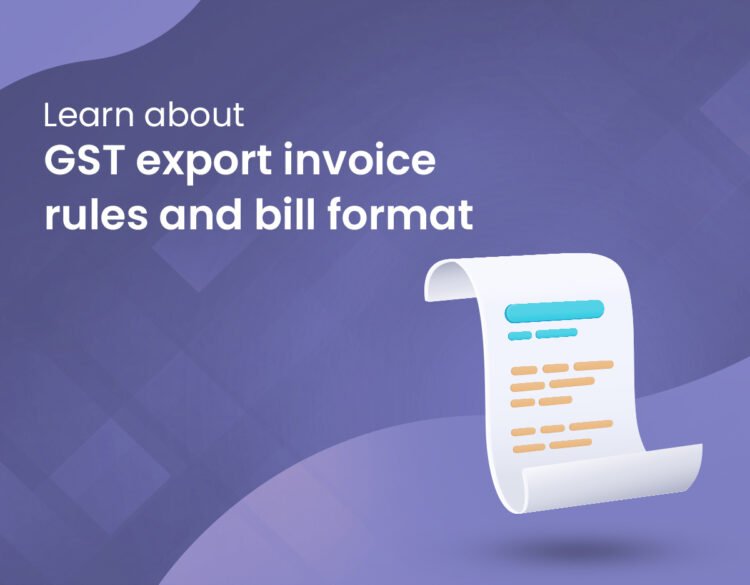A tax invoice is nothing more than a proof of sale, including information on the products or services given, their amount or value, the taxes imposed, etc. It permits the provider to both collect money from the customer and claim ITC under the GST Law.
It is a document that binds both parties to the conditions of sale in a particular transaction. Now, numerous sorts of invoices may be produced based on the nature of the supply, the nature of the products or services delivered, the payment conditions, the type of taxpayers, etc.
Consequently, if a taxpayer is an exporter, he must provide an export invoice. This is analogous to the tax invoice issued for domestic transactions. However, the export invoice contains some extra information.
This article discusses GST Export Invoice Format, their structure, and the details that comprise a tax invoice. But before learning how export invoices are made, let’s examine the key principles that you must be familiar with in order to make export invoices under GST.
How are GST export Invoices Generated?
In the event of taxable goods sales, the invoice must be printed in triplicate.
- Original copy – Recipient
- Copy duplicate – Transporter
- Triplicate copy – Supplier
In the event of taxable services, two copies of the invoice must be created.
- Original copy – Recipient
- Duplicate copy – Supplier
Format of a GST Invoice:
A typical tax invoice, also called an e-invoice, will look like this if it has all 16 mandatory fields required by GST but the basic GST Export Invoice Format is as follows:
- Why you might not want to send a tax invoice
- A person who is registered can’t send a tax invoice when:
- the person receiving it is not on the list;
- The recipient doesn’t need this kind of bill
- Getting More Copies of Bills
The GST Law says that businesses must keep copies of all invoices they send out.
Rules of GST Export Invoice Format
The minimum amount required to generate a GST Export Invoice Format;
When the value of the products or services given is less than INR 200, a tax invoice is not required if –
- If the receiver is not registered
- In the event that the receiver requests an invoice, it is not necessary to provide one.
Nonetheless, a consolidated tax invoice or an aggregated invoice must be created at the conclusion of each day for all such services for which no tax invoice was issued.
Managing URD purchases – Reverse Charge Invoice
In the event of a registered person buying from an “unregistered supplier,” the tax is paid by the receiver, who must provide an invoice upon purchase receipt of the goods or services.
Receiving money in advance – Receipt Voucher
When a licenced dealer receives an advance payment for a supply, the dealer must provide a receipt voucher.
Effectively managing exports – Export Invoice.
In addition to the information necessary for a tax invoice, an export invoice must include the following information:
- The phrases “Supply intended for export on payment of IGST” or “Supply intended for export under bond or letter of undertaking without payment of IGST’ must be present.
- Address and name of the receiver
- Country of final destination
- Delivery address
Special delivery handling – Delivery Challan
Delivery Challans may be granted under certain commercial circumstances, including –
- Supply of liquid gas for which the amount at the time of removal from the supplier’s place of business is unknown
- Transportation of commodities for business purposes
- Transportation of commodities for other than supply-related purposes
- Other reported supplies
Handling amendments to previously issued invoice values – Debit Note / Credit Note
To change the taxable amount or GST Export Invoice Format, the provider must submit a debit note, additional invoice, or credit note.
- Debit Note / Supplemental Invoice – These are provided by a supplier to reflect an increase in taxable value and/or GST charged on the original invoice.
- Credit note – A supplier must provide these to reflect a reduction in taxable value and/or GST charged on the original invoice. Credit note must be provided by the earlier of the 30th September after the end of the fiscal year in which the supply was made OR the date of submitting the appropriate annual report.
Conclusion
Therefore, it can be stated from the preceding explanation that the GST Export Invoice Format
is the fundamental document that is required for the subsequent procedure. It is necessary for inputting the value of supply and tax on incoming and outgoing supplies in GST returns, calculating input tax credit, determining outgoing tax liabilities, etc.
A perfect invoice app called Vyapar maintains an error-free and streamlined operation for both providers and receivers. Therefore, it is the obligation of registered taxpayers to provide correct bills within the stipulated timeframes for the services rendered.








